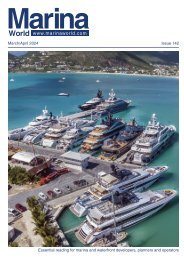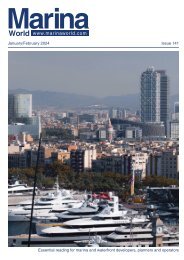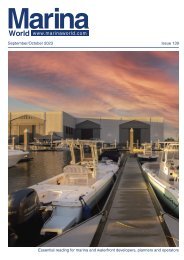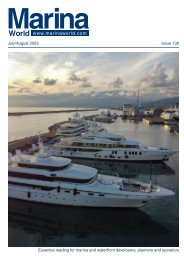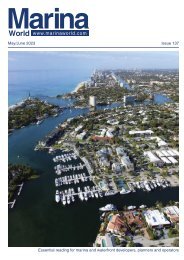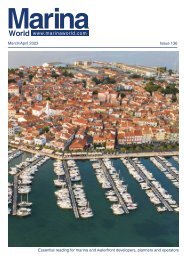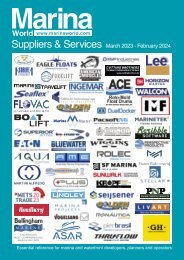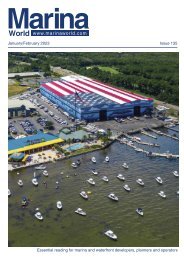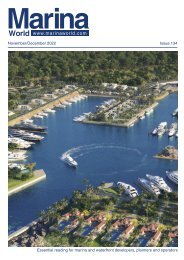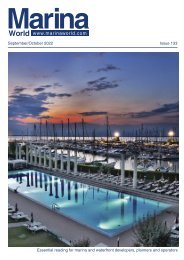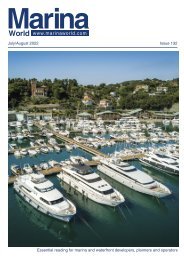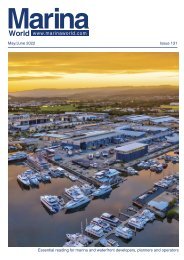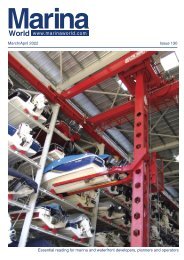2017 July August Marina World
The magazine for the marina industry
The magazine for the marina industry
Create successful ePaper yourself
Turn your PDF publications into a flip-book with our unique Google optimized e-Paper software.
WATERFRONT DEVELOPMENTS<br />
Waterfront points the<br />
way at The Wharf<br />
by Robert Wilkes<br />
It’s a familiar story around the world. The once bustling waterfront, the city’s<br />
gateway to the world, was a tableau of sailing ships awaiting the tide. Then<br />
railroads and later automobiles turned the focus inland. The waterfront became<br />
a forgotten quarter of night clubs and bars surrounded by oily water and foul<br />
air.<br />
By the 1950s and 60s, cities<br />
began building renewal projects that<br />
were mostly unremarkable singleuse<br />
buildings with their backs to the<br />
water. Broad freeways truncated the<br />
waterfront from the rest of the city,<br />
leaving it isolated and neglected.<br />
The dark days of urban waterfront<br />
neglect are over. There is a new sense<br />
of optimism, pride and possibility.<br />
Among a number of ongoing urban<br />
waterfront revitalisation projects, The<br />
Wharf in Washington DC is the largest<br />
in the US and arguably the most<br />
comprehensive and consequential. The<br />
District of Columbia, “the District” as the<br />
locals call it, is turning its face toward<br />
the water again.<br />
The US$2.2 billion project<br />
encompasses 50 acres (20ha) of<br />
water and 24 acres (9.7ha) of upland<br />
improvements. It will feature 3,000,000ft²<br />
(278,709m²) of new residential, office,<br />
hotel, retail, cultural and public space.<br />
The waterside will include waterfront<br />
parks, promenades, piers, docks and<br />
three new marina facilities. A 6,000-<br />
person concert venue called The<br />
Anthem is under construction, as well<br />
as three major hotels. The Wharf is a<br />
testament to what can be accomplished<br />
by private developers working in<br />
partnership with, as well as supported<br />
and encouraged by, the public sector.<br />
Why the trend toward waterfront<br />
renewal? Environmental change<br />
is gradual and easy to take for<br />
granted, but the establishment of the<br />
Environmental Protection Agency<br />
(1970) and the Clean Water Act (1972)<br />
in America deserves some credit.<br />
Similar initiatives around the world have<br />
been equally successful. With a clean<br />
CGI of The Wharf waterfront project.<br />
harbour, planners and builders with<br />
big ideas can dream and anything is<br />
possible. The marina industry’s clean<br />
marina programmes also deserve<br />
praise for this astonishing success.<br />
The site<br />
Pierre l’Enfant designed the distinctive<br />
street patterns and public spaces<br />
of Washington DC in the 1790s. He<br />
formed four quadrants. The smallest,<br />
the southwest quadrant, is an Indiashaped<br />
triangle formed by the<br />
convergence of the Potomac and the<br />
Anacostia Rivers. A dredging project<br />
(1882 to 1890) drained the nearby<br />
marshlands and created the Tidal Basin<br />
(the site of the Jefferson Memorial), and<br />
the two-mile long Washington Channel.<br />
The Channel is sheltered by East<br />
Potomac Park, a manmade landmass<br />
created from dredging material. The<br />
Wharf covers nearly a mile of shoreline<br />
American icons: the Washington Monument<br />
(top left corner); US Capitol (top right<br />
corner); National Mall (in between).<br />
www.marinaworld.com - <strong>July</strong>/<strong>August</strong> <strong>2017</strong> 13



